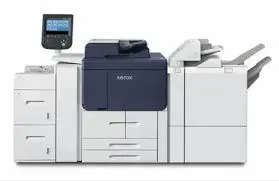
Monitoring Alerts and Status
You can configure alert and status notices to be sent automatically as email messages to one or more recipients.
SETTING UP JOB COMPLETION ALERTS
To set up job completion alerts for email recipients:
-
In the Embedded Web Server, click Properties > General Setup > Alert Notification > Notify Job Completion by Email.
-
For Recipient Email Address, type up to five addresses for recipients to receive job completion alerts.
-
For Targeted Jobs, select the types of jobs for which recipients receive notification when a job completes.
-
For When to Notify, select an option for recipients to receive notification after all job completions or only after job errors occur.
-
In the Message field, type the text to appear in the message.
-
Click Apply.
SETTING UP DEVICE STATUS ALERTS
To set up device alerts for email recipients:
-
In the Embedded Web Server, click Properties > General Setup > Alert Notification > Email Notification for Device Status.
-
For each Recipient’s Email Address, from the Send Notice drop-down list, select a notification frequency option.
-
In the Mail Notice Status Settings area, for each recipient, set the appropriate mail status notification.
-
In the Notice Frequency Settings area, select the notification options for frequency, date, and time.
-
Click Apply.
Cloning
This feature allows you to save your device settings in a clone file. You can use the clone file to copy your device settings to another device, or use it to back up and restore settings on your own device.
Note: If you are using the clone file to copy your device settings to another device, both devices must be the same model and have the same software. To determine the software version of your device:
-
In the Embedded Web Server, click Properties > General Setup > Configuration.
-
Scroll down to the Software section.
SAVING DEVICE SETTINGS
To save device settings to a clone file:
-
In the Embedded Web Server, click Properties > General Setup > Cloning.
-
In the Create Clone File area, select feature settings, as needed. By default, all features are selected.
-
To view the specific parameters that can be cloned for any of the features, click View Feature Details.
-
Click Clone. The Cloning page displays.
-
On the Cloning page, in the Create Clone File area, right-click Cloning.dat and save the file to your computer.
Note: The default name for the file is Cloning.dat. If you rename the file, use .dat as the file extension.
INSTALLING A CLONE FILE
Note: This procedure causes the device to restart. During this time, the device is inaccessible via the network for several minutes.
To install a clone file:
-
In the Embedded Web Server, click Properties > General Setup > Cloning.
-
In the Install Clone File area, click Browse, then navigate to your clone file.
-
Select the file, then click Open.
-
Click Install, then click OK.
Memory Settings
To increase performance, you can allocate memory away from unused ports or you can allocate more memory to heavily used ports.
-
In the Embedded Web Server, click Properties > General Setup > Memory Settings.
-
In the Memory Settings area, specify memory allocation and spooling behavior.
-
Click Apply.
Backup and Restore
You can back up your device and, if needed, restore the settings to the device. The backup process creates a file that is stored on the device. Each time you back up the device, the backup file is overwritten. The process backs up the following data:
-
Network connectivity, and security settings
-
Local user accounting settings
-
Address book entries
-
Information about options installed on the device
-
Job flow sheets
-
Folders used to store files on the device
Note:
-
The backup process backs up the folders, but does not back up files in the folders. To keep the files, before you restore the settings, transfer the files from the device.
-
If you create folders after you create a backup, the new folders are deleted from the device during a restore action.
-
Backup and restore work on a single device. You cannot use the backup file on one device to transfer settings to another device. To transfer settings to another device, use Cloning. You can save specific settings to a clone file, then transfer the settings to another device in your fleet.
BACKING UP DEVICE SETTINGS
To back up device settings:
-
In the Embedded Web Server, click Properties > General Setup > Backup and Restore.
-
For Backup, click Start.
The device creates or overwrites the backup file. The Status area on the Backup and Restore page shows the date and time of the backup.
RESTORING DEVICE SETTINGS
To restore device settings:
-
In the Embedded Web Server, click Properties > General Setup > Backup and Restore.
-
For Restore, click Start.
-
If required, to restart the device, follow the onscreen instructions.
The device settings are restored from the backup file.
Printer Management
You can use the printer management functions to do the following tasks:
-
Export the job history to a comma-separated value file
-
Delete held jobs automatically
-
Specify periods when the printer is locked out
Updating the Device Software
When Xerox releases a new version of device software or firmware, you can update your device to incorporate the new fixes and improvements.
Before you begin:
-
Determine the current device software version.
-
Download the latest software update file for your device model in .bin format from the Drivers and Downloads page.
DETERMINING THE CURRENT SOFTWARE VERSION
-
In the Embedded Web Server, click Properties > General Setup > Configuration.
-
To verify the software version, scroll down to the Software area.
UPDATING THE SOFTWARE
-
In the Embedded Web Server, click Properties > Services > Device Software > Upgrades.
-
For Upgrades, select Enabled.
-
Click Apply.
-
Refresh your browser and navigate to Properties > Services > Device Software > Manual Upgrade.
-
In the Manual Upgrade area, click Browse or Choose File. Locate and select the software upgrade file with the .bin format.
-
Click Open.
-
Click Install Software. The file is sent to the device. After the software is installed, the device restarts.
-
To verify that the software version has updated, check the configuration report.
Printer Management
You can use the printer management functions to do the following tasks:
-
Export the job history to a comma-separated value file
-
Delete held jobs automatically
-
Specify periods when the printer is locked out
EXPORTING JOB HISTORY
To export the job history to a comma-separated values file:
-
In the Embedded Web Server, click Properties > General Setup > Job Management > Export Job History.
-
In the Specify Time Period area, specify the time period when you want to export data. For the Start Date & Time and the End Date & Time fields, enter the information.
-
Click Export file in .csv format.
-
To save the job history file, follow the onscreen instructions.
AUTOMATICALLY DELETING HELD JOBS
To delete held jobs automatically:
-
In the Embedded Web Server, click Properties > General Setup > Job Management > Auto Job Promotion.
-
For Automatically Delete Held Jobs, select Enabled.
-
For Period before Automatic Deletion, type the hours and minutes for the deletion time.
-
Click Apply.
LOCKING THE PRINTER
To lock the printer and make it unavailable for use:
-
In the Embedded Web Server, click Properties > General Setup > Job Management > Printer Lockout.
-
For Printer Lockout, select Enabled.
-
Specify the lockout period:
-
To specify a daily lockout time, for Lockout Duration, select Enabled. For the lockout period, type the start and end time.
-
To lock the printer for whole days, for Lockout Day of Week, select the days for the lockout.
-
To specify a lockout period, for Lockout Period, select Enabled. For the lockout period, type the year, month, and day for the start and end time.
-
Click Apply.
FAQs
How do I troubleshoot common paper handling issues on the Xerox® PrimeLink® C9065/C9070?
Make sure the tray has the correct paper type and size, without overfilling. Clean the feed rollers regularly to prevent jams. If a jam happens, follow the printer’s on-screen instructions to carefully clear the paper.
How to connect the Xerox® PrimeLink® C9065/C9070 to my office network?
Access the network settings via the control panel, select your network type (wired or wireless), and input the necessary credentials. For advanced setups, you may configure IP addresses and proxy settings.
How can I manage user permissions on the Xerox® PrimeLink® C9065/C9070?
Through the admin settings, you can set role-based permissions, allowing you to restrict access to certain features like color printing, scanning, or copying. This helps manage costs and secure sensitive information.
What are the options for tracking printer usage and costs on the Xerox® PrimeLink® C9065/C9070?
The Xerox® PrimeLink® series offers built-in reporting tools that track print volumes, user activity, and material usage. This data can help in cost allocation and optimizing printer utilization across teams.
How do I update the firmware on the Xerox® PrimeLink® C9065/C9070?
Firmware updates can be installed via the printer’s control panel. Navigate to the software update section and follow the prompts to check for and install any available updates. Keeping firmware updated ensures better performance and security.

